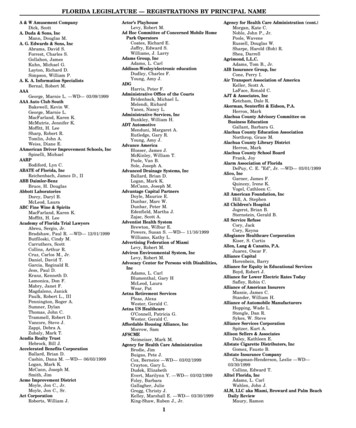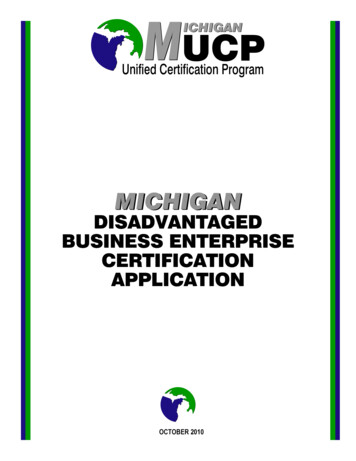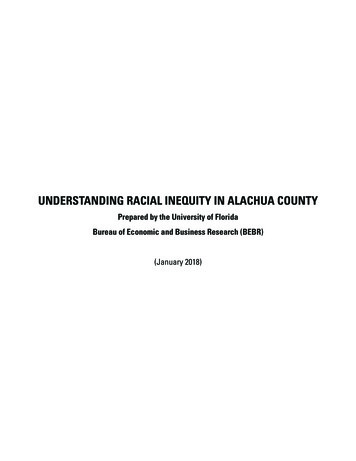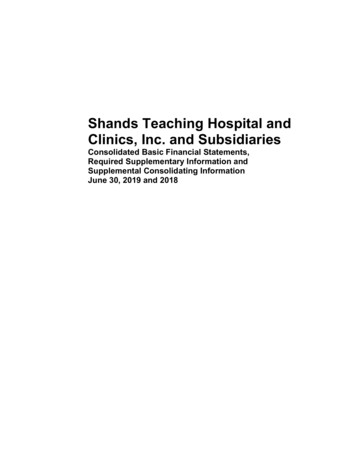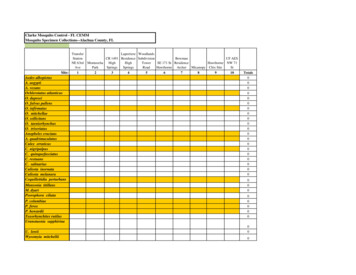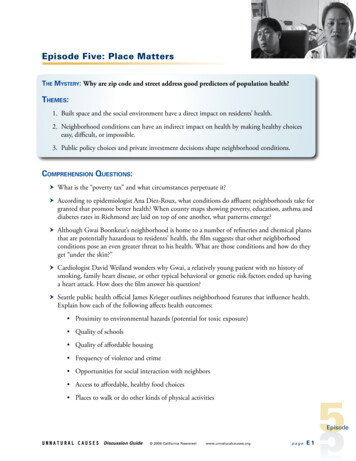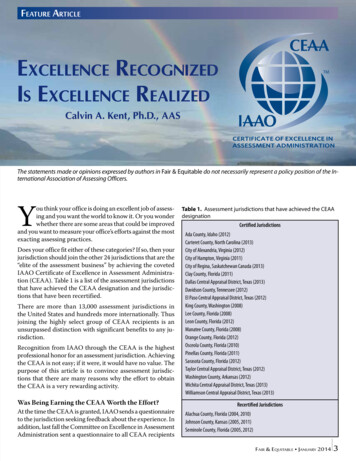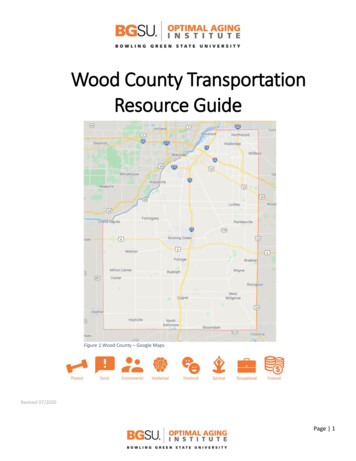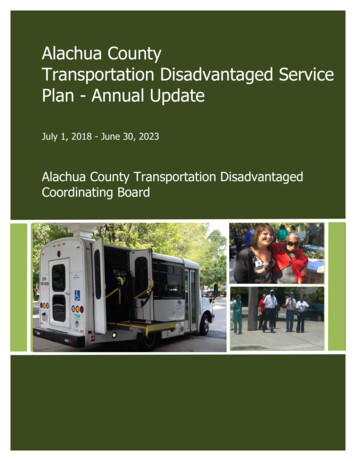
Transcription
Alachua CountyTransportation Disadvantaged ServicePlan - Annual UpdateJuly 1, 2018 - June 30, 2023Alachua County Transportation DisadvantagedCoordinating Board
2018/23 Alachua CountyTransportation DisadvantagedService Plan - Annual UpdateApproved by theAlachua CountyTransportation Disadvantaged Coordinating Board2009 NW 67th PlaceGainesville, FL 32653-1603www.ncfrpc.org/mtpo352.955.2000Charles Chestnut, IV, Chairwith Assistance fromMetropolitan Transportation Planning Organizationfor the Gainesville Urbanized Area2009 NW 67th PlaceGainesville, FL 32653-1603www.ncfrpc.org352.955.2200andMV Contract Transportation, Inc.3713 SW 42nd AvenueGainesville, FL 32608352.375.2784May 8, 2019
THIS PAGE LEFT BLANK INTENTIONALLY
Alachua CountyTransportation Disadvantaged Service PlanTable of ContentsChapter I: Development Plan .1A.Introduction to The Service Area . 1B.Service Area Profile and Demographics. 10C.Service Analysis . 19Chapter II: Service Plan . 29Chapter III: Quality Assurance . 49A.Community Transportation Coordinator Evaluation Process . 49AppendicesAppendix A: Alachua County Transportation Disadvantaged Coordinating Board Grievance Procedures A-1Appendix B: Cost/Revenue Allocation and Rate Structure Justification . B-1Appendix C: Vehicle Inventory . C-1Appendix D: Bus Transit System Annual Safety and Security Certification . D-1Table of ContentsPage i
Alachua CountyTransportation Disadvantaged Service PlanTHIS PAGE LEFT BLANK INTENTIONALLYTable of ContentsPage ii
Alachua CountyTransportation Disadvantaged Service PlanChapter I: Development PlanA.Introduction to The Service AreaThe purpose of this section is to provide information about the organization and development of Florida’sTransportation Disadvantaged Program in Alachua County. This Plan shall serve as the CoordinatedPublic Transit-Human Services Transportation Plan under the federal Moving Ahead for Progress in the21st Century Act (MAP-21).1.Background of Florida’s TransportationDisadvantaged ProgramFlorida's Transportation Disadvantaged Program began in 1979 with the adoption of Chapter 427, FloridaStatutes. The Florida Legislature adopted this legislation to provide transportation disadvantagedservices in a coordinated fashion.The transportation disadvantaged are defined in Chapter 427, Florida Statutes, as:"those persons who because of physical or mental disability, income status, age are unable totransport themselves or purchase transportation and are, therefore, dependent on others toobtain access to health care, employment, education, shopping, social activities, or other lifesustaining activities or children who are handicapped or high-risk or at-risk as defined in s.411.202, Florida Statutes."In 1989, the Florida Legislature reviewed Chapter 427, Florida Statutes according to the State'sRegulatory Sunset Act (Section 11.61, Florida Statutes). During this legislative review, the Legislaturedecided to reenact Chapter 427, Florida Statutes with several revisions.In 1990, Rule 41-2 of the Florida Administrative Code was adopted to implement the provisions ofChapter 427, Florida Statutes. In addition, Rule 41-2 of the Florida Administrative Code assigns theFlorida Commission for the Transportation Disadvantaged with the responsibility to accomplish thecoordination of transportation services provided to the transportation disadvantaged.The following sections discuss each of the major components of the Transportation DisadvantagedProgram.a.Florida Commission for the Transportation DisadvantagedThe Florida Commission for the Transportation Disadvantaged is independent and reports to theGovernor and the Legislature. Chapter 427, Florida Statutes states that:"the purpose of the Commission is to accomplish the coordination of transportation services tothe transportation disadvantaged."The Governor appoints seven members to the Florida Commission for the Transportation Disadvantaged.Five of the members must have significant experience in the operation of a business and two of themembers must have a disability and use the transportation disadvantaged system. The Chair isappointed by the Governor and Vice-Chair is elected annually from the membership of the FloridaCommission for the Transportation Disadvantaged.Development PlanPage 1
Alachua CountyTransportation Disadvantaged Service Planb.Designated Official Planning AgencyThe Designated Official Planning Agency is responsible for transportation disadvantaged planning in agiven area. In the urbanized areas of the state, the planning agencies are metropolitan planningorganizations. In the rural areas of the state, organizations which are eligible to be planning agenciesare: county or city governments regional planning councils metropolitan planning organizations local planning organizations who are currently performing planning activities in the service areaThe Metropolitan Transportation Planning Organization for the Gainesville Urbanized Area is theDesignated Official Planning Agency for Alachua County. According to Rule 41-2 of the FloridaAdministrative Code, responsibilities of the Designated Official Planning Agency include: Appointment of members to the local coordinating boards. Provision of staff support to the local coordinating boards. Recommendation to the Florida Commission for the Transportation Disadvantaged regarding theinitial selection or re-designation of the Community Transportation Coordinator.c.Local Coordinating BoardsThe Designated Official Planning Agency is responsible for appointing a local coordinating board in eachcounty. The purpose of the coordinating board is to provide advice and direction to the CommunityTransportation Coordinator concerning the coordination of transportation services.According to Rule 41-2 of the Florida Administrative Code, the Designated Official Planning Agencyappoints an elected official, to serve as the official chairperson for all local coordinating board meetings.The Board shall elect a Vice-Chair.In addition to the Chair, the following agencies or other groups serve on the local coordinating boards asvoting members: An elected official from Alachua County. A representative of the Florida Department of Transportation. A representative of the Florida Department of Children and Family Services. A representative of the Public Education Community. A representative of the Florida Department of Education. A person recommended by the local Veterans Service Office representing veterans of the county.Development PlanPage 2
Alachua CountyTransportation Disadvantaged Service Plan A person who is recognized by the Florida Association for Community Action as representing theeconomically disadvantaged. A person over age sixty representing the elderly. A person with a disability representing the disabled. Two citizen advocate representatives in the county; one who must be a person who uses thetransportation services of the system as their primary means of transportation. A local representative for children at risk. In areas where they exist, the Chairperson or designee of the local mass transit or public transitsystem's Board. A representative of the Florida Department of Elder Affairs. An experienced representative of the local private for profit transportation industry. A representative of the Florida Agency for Health Care Administration. A representative of the Regional Workforce Development Board. A representative of the local medical community. A local representative of the Florida Agency for Persons with Disabilities. A local representative of the Florida Agency for Persons with Disabilities.The following are some of the duties of the local coordinating board: Approving the Transportation Disadvantaged Service Plan. Annually evaluating the Community Transportation Coordinator's performance. Reviewing all applications for local, state and federal transportation disadvantaged funds.d.Community Transportation CoordinatorThe Community Transportation Coordinator is responsible for ensuring that coordinated transportationservices are provided to serve the transportation disadvantaged. MV Contract Transportation, Inc. is thedesignated Community Transportation Coordinator for Alachua County.MV Contract Transportation, Inc. may provide all or a portion of transportation service in a designatedservice area. MV Contract Transportation, Inc. may subcontract or broker services if it is cost effectiveand efficient. The following are some responsibilities of MV Contract Transportation, Inc.: In cooperation with the planning agency, develop and implement a Transportation DisadvantagedService Plan. Execute contracts for service with transportation operators.Development PlanPage 3
Alachua CountyTransportation Disadvantaged Service Plan Review all applications for federal, state and local funding (in conjunction with the localcoordinating board). Prepare an annual operating report.2.Designation Date/HistoryThe Metropolitan Transportation Planning Organization for the Gainesville Urbanized Area recommendedMV Contract Transportation, Inc. to be designated the Community Transportation Coordinator for AlachuaCounty effective July 1, 2013. The Florida Commission for the Transportation Disadvantaged approvedMV Contract Transportation, Inc.’s designation as the Community Transportation Coordinator for AlachuaCounty. MV Contract Transportation, Inc. was selected as the Community Transportation Coordinatorthrough a request for proposals process.The Florida Commission for the Transportation Disadvantaged requires that the MetropolitanTransportation Planning Organization for the Gainesville Urbanized Area conduct the selection processand recommend a Community Transportation Coordinator for Alachua County at the end of each contractperiod (every five years).In 2018, the Metropolitan Transportation Planning Organization for theGainesville Urbanized Area recommended that MV Contract Transportation, Inc. be re-designated theCommunity Transportation Coordinator for Alachua County.The Florida Commission for theTransportation Disadvantaged re-designated MV Contract Transportation, Inc. as the Alachua CountyCommunity Transportation Coordinator effective July 1, 2018.MV Contract Transportation, Inc. is a private for-profit entity. MV Contract Transportation, Inc. centrallycoordinates rides and provides direct transportation service. The following chart identifies MV ContractTransportation, Inc.’s organizational structure.Development PlanPage 4
Alachua CountyTransportation Disadvantaged Service Plan3.Florida’s Coordinated Transportation SystemOrganization ChartThe following chart identifies the partners involved in Florida’s Transportation Disadvantaged Program.Development PlanPage 5
Alachua CountyTransportation Disadvantaged Service Plan4.Consistency Review of Other Plansa.Local Government Comprehensive PlansThe local comprehensive planning process involves essentially four basic steps:1.the collection and analysis of pertinent data concerning the physical and socio-economiccharacteristics of the study area;2.the formulation of goals for future growth and development;3.the development of objectives and policies guided by the goals which are the essence ofthe Comprehensive Plan;4.the implementation of the Comprehensive Plan.The Transportation Disadvantaged Service Plan is consistent, to the maximum extent feasible, with theAlachua County Comprehensive Plan.Regional Policy Plansb.The North Central Florida Strategic Regional Policy Plan adopted in October 2011 by the North CentralFlorida Regional Planning Council is a long-range guide for the physical, economic and social developmentof a planning region which identifies regional goals and policies. The plan serves as a basis for thereview of the resources and facilities found in local government comprehensive plans originating in theregion. Public transit is addressed in Section V of the plan. Regional Goal 5.6. is to reduce the unmetgeneral trip demand of the north central Florida transportation disadvantaged population.The following policies are included in the Strategic Regional Policy Plan to reduce unmet trip demand: Policy 5.6.1. Improve mobility options for low-income, elderly and disabled citizens. Policy 5.6.2. Increase funding for coordinated transportation systems for the transportationdisabled. Policy 5.6.3. The Council and/or the Metropolitan Transportation Organization for theGainesville Urbanized Area should provide technical assistance to designated north central Floridalocal transportation coordinating boards and community transportation coordinators.The Transportation Disadvantaged Service Plan is consistent, to the maximum extent feasible, with theStrategic Regional Policy Plan.c.Transit Development PlansThe Regional Transit System Transit Development Plan discusses the existing transit system, coordinationwith related plans and policies, transit service needs and a proposed transit service plan. TheTransportation Disadvantaged Service Plan is consistent, to the maximum extent feasible, with theRegional Transit System Transit Development Plan.Development PlanPage 6
Alachua CountyTransportation Disadvantaged Service Pland.Florida Commission for the Transportation Disadvantaged5-Year/20-Year PlanThe Florida Commission for the Transportation Disadvantaged 5-Year/20-Year Plan establishes goals,objectives and a plan of action for the Florida Commission for the Transportation Disadvantaged. Theplan presents forecasts of demand for transportation disadvantaged services, the cost of meeting theforecasted demand, forecasts of future funding for transportation disadvantaged services and approachesto balancing the supply and demand for these services. The plan also provides forecasts of thetransportation disadvantaged population, demand for trips, number of trips supplied, unmet demand fortrips and operating expenses.The Transportation Disadvantaged Service Plan is consistent, to the maximum extent feasible, with theFlorida Commission for the Transportation Disadvantaged 5-Year/20-Year Plan.e.Metropolitan Planning Organization Long-Range Transportation PlanThe Year 2040 Long Range Transportation Plan includes two main elements: an adopted Needs Plan andan adopted Cost Feasible Plan. The Year 2040 Needs Plan charts a strategic direction for how the regionwill achieve important mobility and accessibility goals over the next 25 years. The Year 2040 CostFeasible Plan identifies priority transportation projects and their associated costs. The costs can befunded using projected revenues from a variety of federal, state and local sources over the planninghorizon.The Transportation Disadvantaged Service Plan is consistent, to the maximum extent feasible, with theYear 2040 Long Range Transportation Plan for the Gainesville Urbanized Area.f.Transportation Improvement ProgramThe purpose of the Transportation Improvement Program is to identify all transportation projects withinthe Gainesville Metropolitan Area to be funded by Alachua County, the City of Gainesville, the FloridaDepartment of Transportation, the University of Florida, the Federal Highway Administration (Title 23United States Code) and the Federal Transit Administration (Federal Transit Act). The TransportationImprovement Program identifies all regionally significant transportation projects for which FederalHighway Administration or Federal Transit Administration approval is required whether or not the projectsare to be funded with Title 23 United States Code or Federal Transit Act funds.The Transportation Disadvantaged Service Plan is consistent, to the maximum extent feasible with theTransportation Improvement Program.5.Public ParticipationThe Alachua County Transportation Disadvantaged Board includes representatives of public, private andnon-profit transportation and human services providers as well as the public to participate in thedevelopment and update of the Alachua County Transportation Disadvantaged Service Plan. TheTransportation Disadvantaged Service Plan is developed through input of the Alachua CountyTransportation Disadvantaged Board whose membership includes citizens and human service providers.Development PlanPage 7
Alachua CountyTransportation Disadvantaged Service Plan6.Alachua County Transportation DisadvantagedCoordinating Board Membership CertificationDevelopment PlanPage 8
Alachua CountyTransportation Disadvantaged Service Plan7.Alachua County Transportation DisadvantagedCoordinating Board MembershipDevelopment PlanPage 9
Alachua CountyTransportation Disadvantaged Service PlanB.Service Area Profile and Demographics1.Alachua County Service Area DescriptionAlachua County is located in North Central Florida, 85 miles south of the Georgia state line, 50 miles fromthe Gulf of Mexico, and 67 miles from the Atlantic Ocean. Alachua County encompasses 977 square mileswhich includes approximately 874 square miles of land area. Alachua County has 9 municipalities withinits borders, including: Archer, Alachua, Gainesville (county seat), Hawthorne, High Springs, LaCrosse,Micanopy, Newberry, and Waldo.2.Demographicsa.Alachua County Comprehensive Plan: 2011–2030The Alachua County Comprehensive Plan: 2011-2030 is a long range plan for guiding local decisionmaking and implementing the community’s vision. It consists of fifteen elements addressing aspects ofAlachua County ranging from land use and transportation to natural resource protection in a policyframework adopted by the Alachua County Commission.Transportation Mobility ElementThe Transportation Mobility Element of the Comprehensive Plan creates more mobility options forresidents, especially for young people, the elderly and people who do not own cars or prefer not to drive,which reduces energy use, personal transportation costs, and dependence on foreign oil. It provides forcompact mixed uses areas, including commercial, office, civic and institutional uses to be accessible bywalking and biking, in combination with a plan for bus rapid transit. The Plan also calls for express transitand park and ride opportunities from outlying areas into the employment and commercial hubs within theCity of Gainesville. The following is the goal of the Transportation Mobility Element of theComprehensive Plan and Objective 2.2 relating to transportation needs of transportation disadvantagedresidents of Alachua County:Goal: To establish a multi-modal transportation system that provides mobility for pedestrians, bicyclists,transit users, motorized-vehicle users, users of rail and aviation facilities, and is sensitive to the culturaland environmental amenities of Alachua County.Objective 2.2: Transportation Mobility Element: To coordinate and assist the agencies planning andproviding service delivery for the transportation disadvantaged.Policy 2.2.1: Alachua County will assist the Metropolitan Transportation Planning Organization and theFlorida Department of Transportation in planning services for the transportation disadvantaged.Policy 2.2.2: Alachua County will continue to provide support for the operation of paratransit services inunincorporated Alachua County in order to provide 24-hour ambulatory and wheelchair service on ademand-responsive basis within available financial resources.Development PlanPage 10
Alachua CountyTransportation Disadvantaged Service PlanFuture Land Use ElementThe 2011-2030 Future Land Use Element of the Alachua County Comprehensive Planestablishes policies and standards for the proper distribution and development of varying landuses in the county. Transportation is essential to the development of these land uses as itprovides a means of interaction among these areas. The 2011-2030 Future Land Use Elementof the Alachua County Comprehensive Plan encourages the orderly, harmonious, and judicioususe of land, consistent with the following guiding principles:Principle 1 - promote sustainable land development that provides for a balance of economic opportunity,social equity including environmental justice, and protection of the natural environment.Principle 2 - Base new development upon the provision of necessary services and infrastructure.Focus urban development in a clearly defined area and strengthen the separation of rural and urbanuses.Principle 3 - Recognize residential neighborhoods as a collective asset for all residents of the County.Principle 4 - Create and promote cohesive communities that provide for a full range and mix of land uses.Development PlanPage 11
Alachua CountyTransportation Disadvantaged Service PlanDevelopment PlanPage 12
Alachua CountyTransportation Disadvantaged Service Planb.Population/CompositionThe Bureau of Economic and Business Research estimates Alachua County's total population in 2018 as263,291. Table 1 shows the population of the cities and towns in Alachua County.Development PlanPage 13
Alachua CountyTransportation Disadvantaged Service PlanTABLE 1POPULATION COUNTS AND ESTIMATESALACHUA COUNTYAREAPOPULATION COUNT 2010POPULATION ESTIMATE2018Alachua County247,336263,291City of Alachua9,05910.155City of Archer1,1181,168City of Gainesville124,476131,217City of Hawthorne1,4171,422City of High Springs5,3506,221Town of LaCrosse360390Town of Micanopy600605City of Newberry4,9506,249City of Waldo1,015960Unincorporated Area98,991104,904Source: Bureau of Economic and Business Research, University of FloridaTABLE 2POPULATION DISTRIBUTION IN CENSUSDIVISIONS, CITIES AND TOWNSALACHUA COUNTYU.S. CENSUS POPULATIONPERSONS 65 YEARS ANDOVER, PERCENT247,33612.5%Source: US Bureau of the Census, State & County QuickFactsPERSONS PER SQUARE MILE282.7According to the Bureau of Economic and Business Research, 1,203 individuals are inmates and patientsresiding in federal and state government-operated institutions. They are considered nonresidents of thelocal area for revenue-sharing purposes. Institutionalized individuals are counted as part of the generalpopulation, so they are reflected in statistics on age. However, they are not included in the statistics forincome or poverty levels for households.c.Population DensitiesWith approximately 875 square miles of land area, the County population density in 2010 wasapproximately 282.7 persons per square mile.d.Population ProjectionsAccording to the Bureau of Economic and Business Research, Alachua County will have a total populationof 268,000 by the Year 2020. Illustration I shows population projections for 2020, 2025 and 2030.Development PlanPage 14
Alachua CountyTransportation Disadvantaged Service PlanILLUSTRATION 2030Population Age DistributionPopulation age distribution is useful in determining mobility needs which might be met by transit. Theelderly typically are less likely to have access to a vehicle and thus are more dependent on the transitsystem for their travel needs. Table 3 shows estimates of the County's population by age group.TABLE 3POPULATION ESTIMATES BY AGE GROUPALACHUA COUNTYAge 950-5455-5960-6465-6970-7475-7980-8485 Source: Bureau of Economic and Business Research,Development PlanEstimated 2017 ,9723,9844,568University of FloridaPage 15
Alachua CountyTransportation Disadvantaged Service Planf.Disability and Self Care LimitationsAccording to the Bureau of the Census 2013-2017 American Community Survey 5-Year Estimates,Alachua County had an estimated disabled population of 29,031 in 2017. The estimated populationunder 18 years of age with a disability was 1,565. The estimated population 18 to 64 years of age with adisability was 14,642. The estimated population 65 years and over with a disability was 12,824.g.EmploymentAccording to the Bureau of the Census 2013-2017 American Community Survey, Alachua County'sestimated labor force (individuals who are able to work but may not be employed) in 2017 was 223,856.The estimated labor force participation rate was 59.9. The estimated unemployment rate for AlachuaCounty in 2017 was 4.7 percent.h.IncomeAccording to the 2010 Bureau of the Census, Alachua County’s median household income in 2017 was 45,478. Table 4 characterizes the levels of household income in Alachua County. Table 5 showsincome levels that are currently used to define the federal poverty level.TABLE 4HOUSEHOLD INCOMEALACHUA COUNTY2017 PER CAPITAL INCOME2017 MEDIANHOUSEHOLD INCOME 26,431 45,478Source: 2010 Bureau of the Census, State & County Quick Facts2017 PERSONS BELOWPOVERTY LEVEL PERCENT21.2%TABLE 52019 Poverty Guidelines For The 48 Contiguous StatesAnd The District of ColumbiaPersons In Family/Household2019 Poverty Guideline1 12,4902 16,9103 21,3304 25,7505 30,1706 34,5907 39,0108 43,430* For families/households with more than 8 persons, add 5,230 for each additional person.Source: U.S. Department of Health and Human Services, Office of the Assistant Secretary for Planning andEvaluationDevelopment PlanPage 16
Alachua CountyTransportation Disadvantaged Service PlanAccording to the Florida Agency for Health Care Administration, Florida Department of Health, Division ofPublic Health Statistics & Performance Management, the median monthly Medicaid enrollment for AlachuaCounty in 2017 was 42,493. Table 6 shows individuals who received Supplemental Security Income.TABLE 7PUBLIC ASSISTANCE: AVERAGE MONTHLYCASES BY TYPE OF ASSISTANCEALACHUA COUNTY, 2017TYPE OF ASSISTANCEAVERAGE MONTHLY CASESAged Assistance512Aid to the Blind and Disabled6,030Source: Social Security Administration, Master Beneficiary Record and Supplemental Security RecordHousingi.The 2010 Bureau of the Census reported the total number of households in Alachua County was 97,485and that the average household size was 2.5.Table 8 presents data on housing units.percent of the County's housing units.The Gainesville census division contains approximately 73TABLE 8DISTRIBUTION OF HOUSING UNITSALACHUA COUNTYHOUSING UNITS2017OWNER OCCUPIEDMEDIAN VALUE OFHOUSING UNITOWNER-OCCUPIEDRATEHOUSING UNITS20172017116,96353.6% 167,000Source: 2010 Bureau of the Census, State and County Quick Factsj.HOUSEHOLDS201797,485HealthAccording to the Florida Health 2017 Physician Workforce Annual Report, there were 1,429 physicians ofmedicine practicing in Alachua County.k.TransportationAccording to the Bureau of the Census 2013-2017 American Community Survey 5-Year Estimates, 4,613occupied housing units in Alachua County had no vehicle available.Development PlanPage 17
Alachua CountyTransportation Disadvantaged Service Planl.Major Trip Generators/AttractorsBelow are the existing and projected major trip generators and attractors according to the 2000-2020Alachua County Comprehensive Plan Transportation Mobility Element.Development PlanPage 18
Alachua CountyTransportation Disadvantaged Service PlanC.Service Analysis1.General and Critical Need TransportationDisadvantaged PopulationsThe National Center for Transit Research Center for Urban Transportation Research developed amethodology for estimating the general and critical need Transportation Disadvantaged population basedon the most current U.S. Census Bureau demographic and socio-economic data available. The generalTransportation Disadvantaged population includes the estimates of all disabled, elderly, low incomepersons and children who are ‘high-risk” or “at-risk.”The critical need Transportation Disadvantaged population includes individuals who, due to sever physicallimitations or low incomes, are unable to transport themselves or purchase transportation and aredependent upon others to obtain access to health care, employment, education, shopping, socialactivities, or other life sustaining activities.The following tables show general and critical need Transportation Disadvantaged population estimatesfor Alachua County.Development PlanPage 19
Alachua CountyTransportation Disadvantaged Service PlanDevelopment PlanPage 20
Alachua CountyTransportation Disadvantaged Service PlanDevelopment PlanPage 21
Alachua CountyTransportation Disadvantaged Service Plan2.Paratransit Service Demand EstimationThe National Center for Transit Research Center for Urban Transportation Research developed aparatransit service demand estimation tool based on the most current U.S. Census Bureau demographicand socio-economic data available. The following table shows trip demand for the critical TransportationDisadvantaged population.Development PlanPage 22
Alachua CountyTransportation Disadvantaged Service Plan3.Barriers to CoordinationMedicaid non-emergency transportation services are no longer coordinated through Florida’s CoordinatedTransportation System in Alachua County.In May 2014, the Florida Agency for Health CareAdministration implemented Florida’s Managed Medical Care Program. The Managed Medical CareProgram requires Managed Medical Assistance Plans to provide transportation to their enrollees who haveno other means of transportatio
Gainesville, FL 32608 352.375.2784 May 8, 2019. THIS PAGE LEFT BLANK INTENTIONALLY. . Florida's Transportation Disadvantaged Program began in 1979 with the adoption of Chapter 427, Florida . given area. In the urbanized areas of the state, the planning agencies are metropolitan planning .
